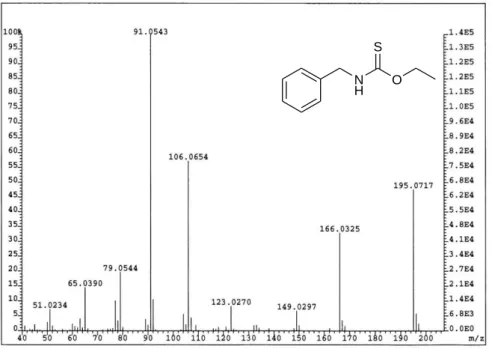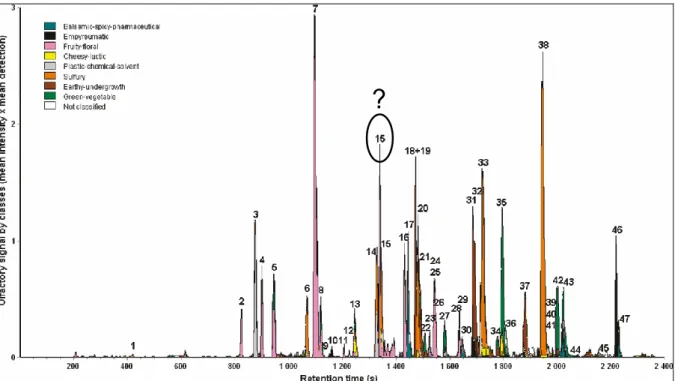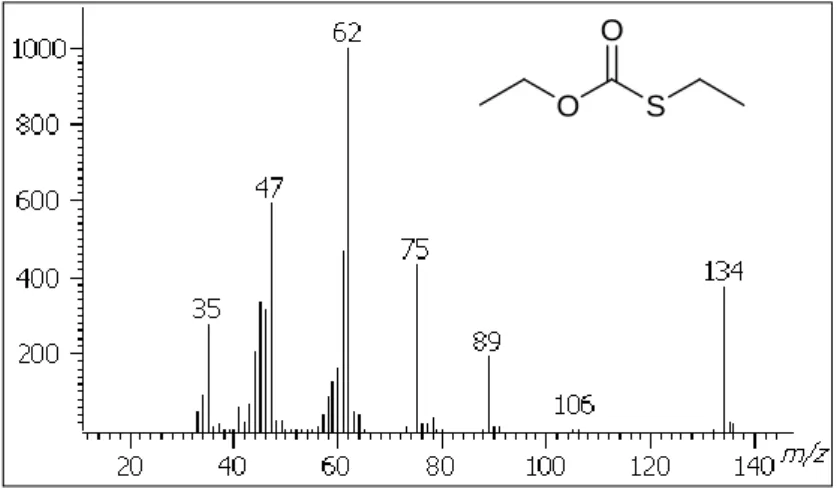HAL Id: hal-02755932
https://hal.inrae.fr/hal-02755932
Submitted on 3 Jun 2020HAL is a multi-disciplinary open access
archive for the deposit and dissemination of sci-entific research documents, whether they are pub-lished or not. The documents may come from teaching and research institutions in France or abroad, or from public or private research centers.
L’archive ouverte pluridisciplinaire HAL, est destinée au dépôt et à la diffusion de documents scientifiques de niveau recherche, publiés ou non, émanant des établissements d’enseignement et de recherche français ou étrangers, des laboratoires publics ou privés.
Identification of new odorants in Indian Cress
(Tropaeolum majus L.), Structure-activity study on
synthesized homologues
Katharina Breme, Xavier Fernandez, E. Sarrazin, Hugues Brevard, Daniel
Joulain, Pascal Tournayre, Jean-Louis Berdagué, Uwe Meierhenrich
To cite this version:
Katharina Breme, Xavier Fernandez, E. Sarrazin, Hugues Brevard, Daniel Joulain, et al.. Identifica-tion of new odorants in Indian Cress (Tropaeolum majus L.), Structure-activity study on synthesized homologues. 9. Wartburg symposium on flavour chemistry and biology, Apr 2010, Eisenach, United Kingdom. Deutsche Forschungsanstalt für Lebensmittelchemie, 6 p., 2010, 9èmes Wartburg sympo-sium on Flavour Chemistry and Biology. �hal-02755932�
IDENTIFICATION OF NEW ODORANTS IN INDIAN CRESS
(TROPAEOLUM MAJUS L.); STRUCTURE-ACTIVITY STUDY OF
SYNTHESIZED HOMOLOGUES
K. BREME1,2, X. Fernandez1, E. Sarrazin1, H. Brevard3, D. Joulain3, P. Tournayre4, J.-L. Berdagué4, U. J. Meierhenrich1
1
University of Nice-Sophia Antipolis, LCMBA CNRS UMR 6001, Parc Valrose, 06108 Nice cedex 2, France
2
Current address: Agroscope Liebefeld-Posieux Research Station ALP, 3003 Berne, Switzerland
3
Robertet S.A., BP 52100, 06131 Grasse cedex 2, France
4
French National Institute for Agronomic Research (INRA), Clermont-Ferrand, France Abstract
This paper reports on the analysis of Indian cress absolute (Tropaeolum majus L.). Indian cress is an edible cress species that belongs to the Brassicale order. Its absolute, obtained by extraction of the plant with a non-polar solvent (concrete) followed by treatment with ethanol, has never been studied. It was analyzed by GC-MS and GC-O in order to characterize its main volatile compounds and key odorants. This research made it possible to identify two new volatile compounds: N-benzyl O-ethyl thiocarbamate and O,S-diO-ethyl thiocarbonate. To the best of our knowledge, both compounds were reported in cress extract for the first time. These molecules being of organoleptic interest, 27 homologues were further synthesized and evaluated. Among those new volatiles, N-phenyl thiocarbamates were shown to be particularly interesting for their savory and meaty odors.
Introduction
One of our main research goals is the study of natural matrices used in perfumery in order to identify new natural odorants with low perception thresholds. We particularly focus on organonitrogen and -sulfur compounds because their presence in a matrix, even in sub-ppb quantities, can provoke a significant effect on the organoleptic properties of the matrix [13].
With this intention, we analyzed Indian cress absolute. Indian cress (Tropaeolum
majus L.) is an edible cress species that belongs to the Brassicale order. Brassicales
are known to produce glucosinolates which are among the major precursors of sulfur- and nitrogen-containing molecules [4]. However, to our knowledge, the key volatile compounds of Indian cress absolute have never been studied. The absolute is a perfumery solvent material obtained by extraction of the plant with a non-polar solvent (concrete) and then treatment with ethanol.
In this work, Indian cress absolute was analyzed by GC-MS and GC-O. Two new volatile compounds were identified: O,S-diethyl thiocarbonate and N-benzyl O-ethyl
2
thiocarbamate. To the best of our knowledge, both compounds were reported in a cress extract for the first time. These molecules being of organoleptic interest, 27 homologues were further synthesized, then evaluated, and are presented in this paper.
Experimental
GC-MS. Analyses were performed as described by Breme et al. [57].
GC-Olfactometry. GC-Olfactometry analyses were performed using an Agilent gas
chromatograph 4890D (Agilent) and an eight-way sniffing multiport device (8W-GC-O), recently designed by Berdagué et al. [8].
Headspace Solid-Phase MicroExtraction - Comprehensive Two-dimensional GC coupled to a Time-of-Flight Mass Spectrometer (HS-SPME-GC×GC-TOFMS).
Analyses were performed as described by Breme et al. [6–7], using a 6890N chromatograph (Agilent) equipped with two separate ovens, a time-of-flight mass spectrometer LECO Pegasus 4D (LECO Corporation, St. Joseph, MI), and a cryogenic modulator (LECOQuad JetModulator).
Synthesis of Thiocarbamates. Thiocarbamates were obtained by addition of
anhydrous alcohol (methanol, ethanol, or 1-propanol; 50 mmol) to alkyl isothiocyanate (10 mmol), as described by Breme et al. [5]. The corresponding thiocarbamates gave yields between 25 % and 96 % with a GC purity range of 97–
99 %.
Synthesis of Thiocarbonates. Thiocarbonates were obtained by slow addition of
S-alkyl chlorothioformate (S-methyl, S-ethyl or S-propyl; 4 mmol) to anhydrous alcohol (methanol, ethanol, or 1-propanol; 4 mmol) in the presence of pyridine (4 mmol) and dichloromethane (3 mL), as reported by Breme et al. [6]. Thiocarbonates were obtained in yields from 9 % to 93 % with GC purities between 90 % and 96 %.
Results
Identification of N-benzyl O-ethyl thiocarbamate. The GC-MS analysis of Indian cress
absolute revealed the presence of a major unknown compound that represented 84 % of the Total Ion Current (TIC). This compound was isolated by silica gel fractionation and then analyzed by HR-MS and NMR. On the basis of the HR-MS results, an empirical formula was proposed as C10H13NOS (m/z found 195.0717 u,
m/z calculated 195.0718 u) (Figure 1) [5]. Moreover, the fragments (m/z 91.0543 u)
and (m/z 106.0654 u) suggested the presence of a benzyl-NH group. In addition, NMR analysis (1H and 13C) showed the presence of an ethoxy group and demonstrated the co-existence of two rotamers due to a restricted rotation of a C–C bound. As a consequence, the structure of N-benzyl O-ethyl thiocarbamate was hypothesized and synthesized. The mass spectrum and linear retention indices of the synthetic N-benzyl O-ethyl thiocarbamate were identical to data obtained from Indian cress absolute and confirmed its identification. N-benzyl O-ethyl thiocarbamate had already been reported in an African Brassicale (Pentadiplandra brazzeana) [9], but
was reported in cress for the first time. As this compound is rarely found in plants and was not detected in the Indian cress concrete, its origin was studied. Benzyl isothiocyanate is known as a major compound of Indian cress (concrete). As the absolute is obtained by addition of ethanol to the concrete, N-benzyl O-ethyl thiocarbamate was supposed to result from the addition of ethanol on benzyl isothiocyanate (Figure 2) [5]. Experiments performed on cress concrete confirmed this reaction. Consequently, N-benzyl O-ethyl thiocarbamate seemed to result rather from the absolute preparation conditions than from the plant metabolism.
N
H O
S
Figure 1. Mass spectrum of N-benzyl O-ethyl thiocarbamate identified in Indian cress
absolute.
Figure 2. Formation of thiocarbamates in Brassicales during absolute preparation
8W-GC-O analysis of Indian cress absolute. Using the 8W-GC-O device recently
designed by Berdagué et al. [8], Indian cress absolute was analyzed to characterize its key odorants. In this study, GC-O analysis was perfomed twice by eight judges. During the sniffing sessions, the sniffers were instructed (a) to signal each odor perceived by pressing a push button for as long as the odor lasted, (b) to describe the odors orally, and (c) to quantify their intensity on a five-point scale. The data were then compiled using the VIDEO-Sniff software by breaking the total olfactory signal (TOS, sum of the 16 individual aromagrams) up into olfactory classes that were defined during data processing, in order to highlight the key-odor zones of an
4
aromagram. Using this data treatment, 44 odorants were characterized (Figure 3). Out of them, 22 were identified using comprehensive two-dimensional GC coupled to a time-of-flight-mass spectrometer (GCGC-TOFMS). The main odoriferous compounds were identified as (E)-2-hexenal (7), diethyl trisulfide (38), an unknown fruity-sulfury compound (15), 1-octen-3-one (18), 1-octen-3-ol (19), 2-butylthiophene (33), 2-nonanone (35), and an unknown pyrazine (46) [7]. Most of them were reminiscent of fruity, green, mushroom, and sulfury nuances, which demonstrated the overall influence of sulfury and fruity notes in the olfactory profile of Indian cress absolute.
Figure 3. VIDEO-Sniff aromagram of Indian cress absolute, obtained with 16 judges.
The breakdown of the mean total olfactory signal (TOSInt_Det) into nine
classes shows the odorant zones belonging to a given olfactory class. The compound 15 corresponds to O,S-diethyl thiocarbonate.
Identification of O,S-diethyl thiocarbonate. The key odorant 15 highlighted by
8W-GC-O was reminiscent of red fruit and slightly sulfury. This compound was detected by 15 out the 16 judges and presented a mean intensity of 4.3/5. Due to its appealing sensory properties, it had to be identified. However, compound 15 represented only 0.1 % of the TIC and could harldy be isolated by flash chromatography. Using GCGC-TOFMS, a mass spectrum corresponding to this odorant was obtained. Its molecular mass was determined as m/z 134 u (Figure 4). Its isotopic peak pattern clearly demonstrated the presence of sulfur. Using preparative GC, this unknown odorant was isolated from the raw absolute and NMR (1H and 13C) was performed on the collected volatiles (3 mg). NMR proved the presence of a carbonyl group, as well as an ethoxy group, and an ethylthio group. On the basis of these data, the structure of O,S-diethyl thiocarbonate was proposed. It was synthesized and the data of the synthetic compound confirmed its identification in Indian cress absolute [8]. As far as we know, this compound was reported in cress for the first time. However, it has already been isolated in wine [10], as well as in pineapple [11]. Its origin remained
unclear. It might either result form the plant metabolism, or be formed during the absolute preparation from the corresponding acid.
O S O
Figure 4. Mass spectrum of O,S-diethyl thiocarbonate identified in Indian cress
absolute.
Table 1. Thiocarbamates and thiocarbonates synthesized.
R2 R1 LRI Olfactory evaluation by GC-O
HP-1 Innowax
Thiocarbamate methyl ethyl 1046 1312 rubber, plastic, grilled
R1 N H O S R2 allyl 1115 1948 garlic
3-(methylthio)propyl 1556 2667 green, cress
benzyl 1608 2766 green, faint odor
phenyl 1536 2601 phenolic, geranium, green
phenylethyl 1703 2827 mushroom
ethyl ethyl 1121 1878 grilled, a little bitter
allyl 1195 1979 garlic, cooked garlic, onion
3-(methylthio)propyl 1620 2696 green, cress, radish, pungent benzyl 1687 2784 green, cress, mild, faint odor
phenyl 1592 2620 salty, bacon, smoked
phenylethyl 1773 2847 mushroom, green, moss, wet forest
propyl ethyl 1219 1970 green, plastic
allyl 1286 2069 spearmint
3-(methylthio)propyl 1730 2770 green
benzyl 1784 2868 green, floral, almond-like
phenyl 1692 2690 smoked, sweet-vanilla
phenylethyl 1875 2929 mushroom
Thiocarbonate methyl methyl 767 1148 fruity, faint
R2
S O
O R1
ethyl 829 1200 sulfury, pineapple
propyl 926 1273 sulfury, main gas
ethyl methyl 825 1200 sulfury-fruity, pineapple ethyl 906 1240 fruity, red fruit, sulfury
propyl 1001 1317 sulfury
propyl methyl 924 1280 alliaceous, fruity
ethyl 1002 1325 red fruit, alliaceous
6
Synthesis of homologues of thiocarbamates and thiocarbonates. As N-benzyl O-ethyl
thiocarbamate and O,S-diethyl thiocarbonate presented interesting sensory properties, homologues were synthesized. Six different isothiocyanates known for their presence in Brassicale plants were used for the synthesis of thiocarbamate homologues: allyl isothiocyanate, benzyl isothiocyanate, ethyl isothiocyanate, 3-(methylthio)propyl isothiocyanate, phenyl isothiocyanate, and phenylethyl isothiocyanate [4]. In total, 18 O-alkyl thiocarbamates were synthesized following a chemical pathway similar to that used for the synthesis of N-benzyl O-ethyl thiocarbamate. In addition, nine thiocarbonates were synthesized, as described by Breme et al. [6], by addition of alcohols on S-alkyl chlorothioformates. These 27 compounds were evaluated by GC-O, and their olfactory descriptors, as well as their linear retention indices (LRI) are listed in Table 1.
N-alkyl thiocarbamates were also evaluated by two flavorists from Robertet S.A.
(Grasse, France). N-phenyl thiocarbamates were particularly appealing for the flavorists due to their savory nuances. They were tested in a meat flavor and were demonstrated to bring cooked pork nuances, and to be less fatty and greasy. As a result, they could be useful in the composition of meat aromas.
References
1. Kraft P., Bajgrowicz, J. A., Denis, C., Frater, G. (2000) Angew. Chem. Int. Ed. 39: 29803010.
2. Boelens, M.H. (1993) Perfum. Flavor. 18: 2939. 3. Goeke, A. (2002) Sulfur Reports 23: 243278.
4. Fahey, J. W., Zalcmann A. T., Talalay, P. (2001) Phytochemistry 56: 551.
5. Breme, K., Fernandez, X., Meierhenrich, U, Brevard, H., Joulain, D. (2007) J. Agric. Food Chem. 55: 19321938.
6. Breme K., Guillamon, N., Fernandez, X., Tournayre, P., Brevard, H., Joulain, D., Berdagué, J.-L., Meierhenrich, U. (2009) J. Agric. Food Chem. 57: 25032507 7. Breme, K., Tournayre, P., Fernandez, X., Meierhenrich, U., Brevard, H., Joulain,
D., Berdagué, J.-L. (2010) J. Agric. Food Chem. 58: 473-480.
8. Berdagué, J.-L., Tournayre, P., Cambou, S. (2007) J. Chrom. A 1146: 85-92. 9. El-Migirab, S., Berger, Y., Jadot, J. (1977) Phytochem. 16: 1719-1721.
10. Krammer, G. E., Guntert, M., Lambrecht, S., Sommer, H., Werkhoff, P., Kaulen, J., Rapp, A. (1998) ACS Symp. Ser. 714: 53-65.
11. Tamura, H., Ebeler, S. E., Kubota, K., Takeoka, G. R., (2008) ACS Symp. Ser. 788: 57-67.


